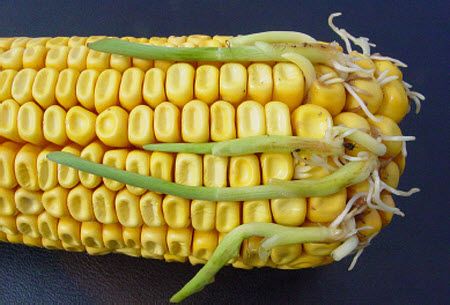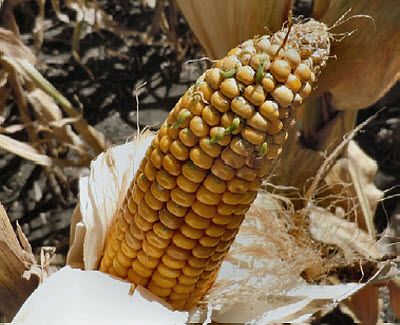Soil Bound LLC | 570-380-3153
Soil Bound LLC | 570-380-3153
Wet fall weather conditions can lead to premature germination ("vivipary") of corn kernels on the ear in some fields. Hybrids affected have ears that are still in the upright position on stalks, which allows water to pool in the husks for extended periods. Corn germination is regulated by a hormone balance within the kernel. If this balance is tilted toward "germination" as opposed to "storage," and the environment is ideal for absorption of water by kernels, sprouting may occur. Premature germination of kernels on the ear is most likely to occur when kernels have dried down to 20% moisture or less and are then rewetted by fall rains.

Figure 1. Premature germination (vivipary) of corn kernels on ear in the fall. Kernels on butt of ear sprouting due to wet weather and water collecting in husk of upright ear.
Seed maturation, storability, and germination are not distinctly separate physiological events during corn kernel development. Rather, these stages all occur along a continuum within the seed and are regulated by hormonal balances. This internal regulation normally prevents the kernels from germinating while on the mother plant.
Physiological "Switch" in Kernels: The balance between 2 plant hormones, abscisic acid and gibberellic acid, is critical in determining if a seed will become dormant and have good storability, or start into the germination phase. This balance is affected by changes in kernel moisture and environmental stresses that occur during kernel development such as drought and heat stress.
Disease Relationship: Gibberellic acid is also produced by many common fungi, such as ear rot organisms. This hormone production signals the seed to activate defense genes, but it may also interfere with the abscisic acid/gibberellic acid balance in the seed and promote germination.
In cases of grain sprouting on the ear, growers should monitor fields closely, harvest early, dry grain sufficiently and develop a strategy to successfully store and market affected grain to minimize economic impacts.

In-Field Management: A few sprouts on 5% or less of ears are unlikely to cause problems with grain quality. However, if serious sprouting problems have developed, harvesting as soon as possible and drying grain adequately are the best ways to keep the problem from getting worse.
Drying: Consider drying affected grain at a kernel temperature of 120 F to kill and desiccate the developing sprout. Also consider removing an additional point of moisture (dry to 14% rather than 15%, for example) to improve storability.
Screening: After drying, use a rotary screen, gravity screen or perforated auger housing section to screen the grain prior to storage. The goal is to remove as much of the desiccated sprout material as possible.
Storage: With lower quality grain, it is critical to employ all best management practices for grain storage:
"Core" the bin by removing 10% of the total bin capacity after filling to remove fines that accumulate in the center.
Aerate by running fans to cool the grain prior to winter.
Monitor grain carefully for hot spots or spoilage, especially if sprouted grain may be consolidated in pockets in the bin:
Feeding: If grain molds have developed, check grain for toxins before feeding it to livestock (especially female breeding stock).
Marketing: Long-term storage of lower quality grain is risky. Attempt to move sprouted grain through the system early to minimize grain quality changes in storage.